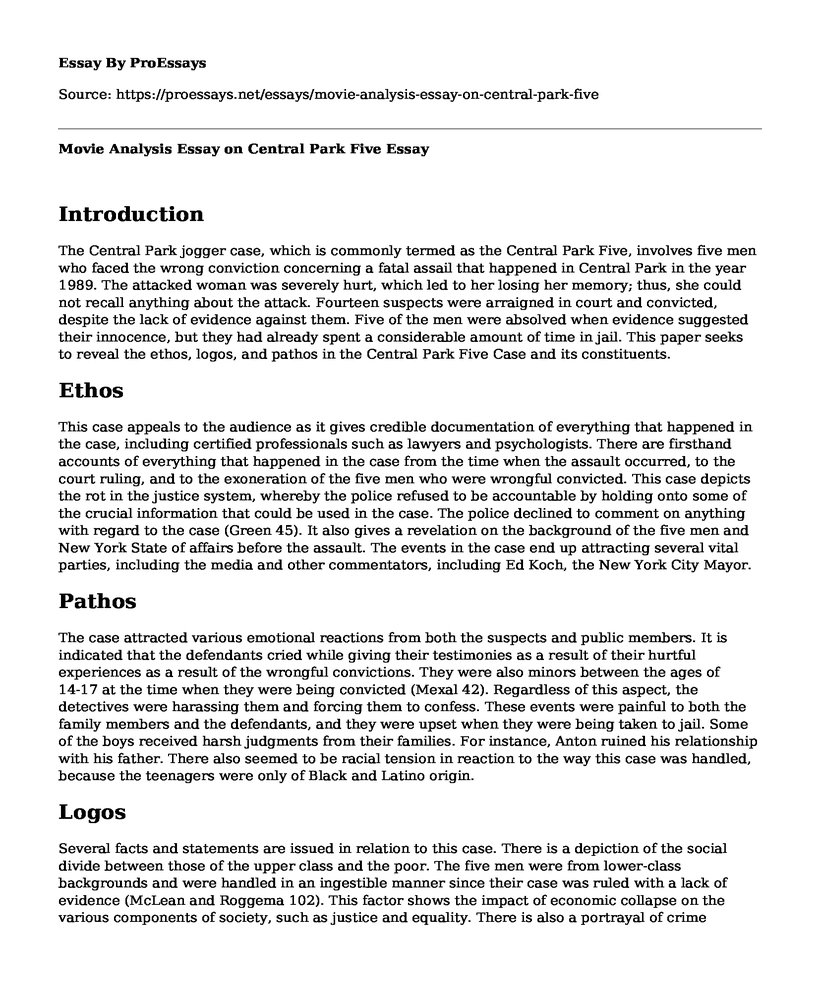Introduction
The Central Park jogger case, which is commonly termed as the Central Park Five, involves five men who faced the wrong conviction concerning a fatal assail that happened in Central Park in the year 1989. The attacked woman was severely hurt, which led to her losing her memory; thus, she could not recall anything about the attack. Fourteen suspects were arraigned in court and convicted, despite the lack of evidence against them. Five of the men were absolved when evidence suggested their innocence, but they had already spent a considerable amount of time in jail. This paper seeks to reveal the ethos, logos, and pathos in the Central Park Five Case and its constituents.
Ethos
This case appeals to the audience as it gives credible documentation of everything that happened in the case, including certified professionals such as lawyers and psychologists. There are firsthand accounts of everything that happened in the case from the time when the assault occurred, to the court ruling, and to the exoneration of the five men who were wrongful convicted. This case depicts the rot in the justice system, whereby the police refused to be accountable by holding onto some of the crucial information that could be used in the case. The police declined to comment on anything with regard to the case (Green 45). It also gives a revelation on the background of the five men and New York State of affairs before the assault. The events in the case end up attracting several vital parties, including the media and other commentators, including Ed Koch, the New York City Mayor.
Pathos
The case attracted various emotional reactions from both the suspects and public members. It is indicated that the defendants cried while giving their testimonies as a result of their hurtful experiences as a result of the wrongful convictions. They were also minors between the ages of 14-17 at the time when they were being convicted (Mexal 42). Regardless of this aspect, the detectives were harassing them and forcing them to confess. These events were painful to both the family members and the defendants, and they were upset when they were being taken to jail. Some of the boys received harsh judgments from their families. For instance, Anton ruined his relationship with his father. There also seemed to be racial tension in reaction to the way this case was handled, because the teenagers were only of Black and Latino origin.
Logos
Several facts and statements are issued in relation to this case. There is a depiction of the social divide between those of the upper class and the poor. The five men were from lower-class backgrounds and were handled in an ingestible manner since their case was ruled with a lack of evidence (McLean and Roggema 102). This factor shows the impact of economic collapse on the various components of society, such as justice and equality. There is also a portrayal of crime increase as it is revealed that there were 84 crack wars. Additionally, the DNA test was not a match; hence the case should have been stopped, but it was continued (Beardsley and Teresa 166). The police pressurized the accused into giving false accounts of events.
Rhetorical Devices
The film incorporates the use of several rhetorical devices such as imager, first-person narrative, and repetition. Imagery is used whereby there are videos and pictures to help the viewers see what the defendants were narrating. Also, the narrations at the start of the film give a more personal touch to the audience as they are issued in the first person. There is repetition whereby the documentations on the news and interrogation showcase consistent use of the words; do you understand?' to accentuate the ruthless process of grilling and the pain that the teenagers underwent.
Conclusion
The Central Park Five Case brings attention to the case, its inconsistencies, and the objectives behind it. It shows some of the injustices in the criminal justice system and the need to settle them. It also looks into corruption and media rage in relation to criminal cases.
Works Cited
Beardsley, Kathryn, and Carrie Teresa. "The Journey from" Just Us" to Some" Justice": Ideology and Advocacy, the New York Amsterdam News, and the Central Park Jogger Story." American Periodicals: A Journal of History & Criticism 27.2 (2017): 165-179.
Green, David A. "Savage Portrayals: Race, Media, and the Central Park Jogger Story." (2017): 44-46.
Mexal, Stephen J. "The Roots of "Wilding": Black Literary Naturalism, the Language of Wilderness, and Hip Hop in the Central Park Jogger Rape." African American Review 46.1 (2013): 101-115.
McLean, Lisa, and Rob Roggema. "Planning for a prosumer future: The case of Central Park, Sydney." Urban Planning 4.1 (2019): 172-186.
Cite this page
Movie Analysis Essay on Central Park Five. (2023, Apr 20). Retrieved from https://proessays.net/essays/movie-analysis-essay-on-central-park-five
If you are the original author of this essay and no longer wish to have it published on the ProEssays website, please click below to request its removal:
- Music Psychology Essay Example
- The Influence of Social Media on Teen's Self Esteem Paper Example
- Interpersonal Conflict in Big Bang Film Essay Example
- Facebook Usage and Interpersonal Privacy
- Video Analysis Essay on The Mystery of Storytelling
- Modern Perennial Garden: Prairie Planting Style - Essay Sample
- The Revolutionary Impact of Phil Spector's Wall of Sound in Music Production - Essay Example







